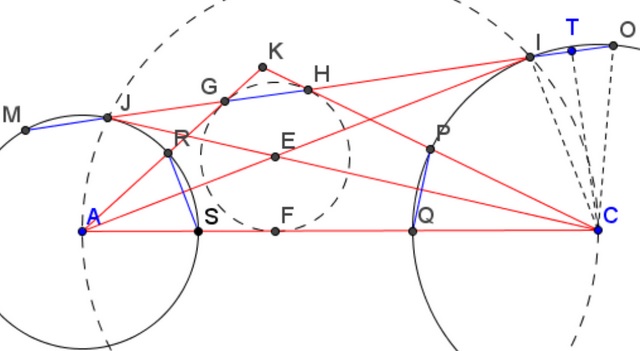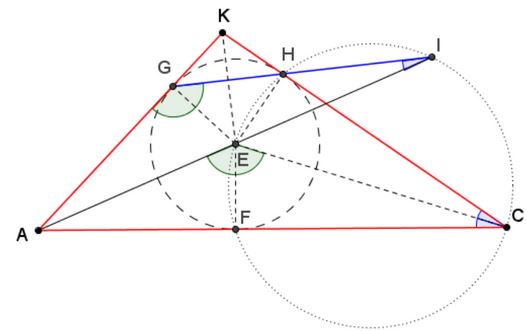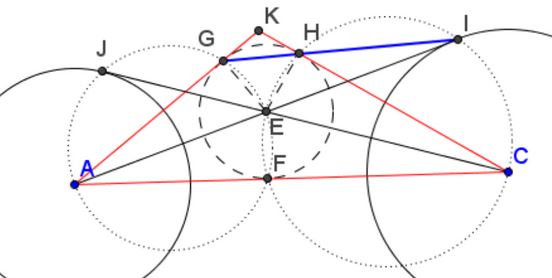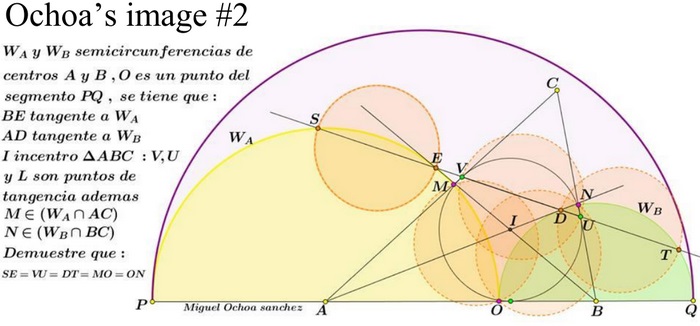Shedding Light on the Ball for Eyeballing
E. A. J. García
27 June, 2014
Recall Dao's Eyeballing a Ball problem.

In this case the segments $IJ,$ $GH$ are not necessarily congruent to those segments corresponding to the Praying Eyes Theorem. So, one would ask: when segments $IJ,$ $GH$ are equal to those of the Praying Eyes Theorem? Well, Ochoa has answered the question by misinterpreting Dao's problem.

In Ochoa's image at CTK-Facebook, he takes $ABD$ as a triangle with $C$ as its incenter, which is different from Dao's configuration. Ochoa also stated that $MN$ equals $IJ = GH.$
Now I will prove that $IJ = GH = MN,$ but I will change the notations.
Consider two circles $(A),$ $(C).$ From $A$ draw a line tangent to $(C)$ at $I.$ From $C$ draw a line tangent to $(A)$ at $J.$ Let $E$ be the intersection of $AI$ and $CJ.$ Draw a circle centered at $E$ and tangent to $AC$ at $F.$ Now, from $A$ draw a line tangent to $(E)$ at $G$ and from $C$ draw another line tangent to $(E)$ in $H.$ Let $K$ be the intersection of $AG,$ $CH.$

Let $CT\perp IO.$
$\begin{align} \angle TIC&=180^{\circ}-90^{\circ}-\angle JIA=90^{\circ}-\angle JIA,\\ \angle TCI&=90^{\circ}-(90^{\circ}-\angle JIA)=\angle JIA=\angle JCA,\\ \angle ECF &=\angle HCE, \end{align}$
so $CP=CQ,$ implying $CE\perp PQ.$
It follows easily that triangles $COI$ and $CPQ$ are congruent and therefore $OI = PQ.$
Now I will prove that $G,$ $H$ are on segment $IJ.$
Let $ACK$ be a triangle with $E$ as the incenter. Let $FGH$ be the intouch triangle of $ACK.$ Let the bisector $AE$ intersect circle $(CHEF)$ in $I.$

Then $G,$ $H,$ $I$ are collinear.
Indeed,
$\begin{align} \angle AKC&=180^{\circ}-\angle KAC-\angle KCA,\\ \angle KGH&=(180^{\circ}-\angle AKC)/2, \\ \angle KGH&=\angle KAC/2+\angle KCA/2,\\ \angle AGH&=180^{\circ}-\angle KAC/2-\angle KCA/2,\\ \angle AEC&=180^{\circ}-\angle KAC/2-\angle KCA/2. \end{align}$
Hence, $\angle AGH=\angle AEC.$
Also, $\angle EIH = \angle ACE.$ So, $AEIG$ is a triangle and is similar to $\Delta AEC.$ Which means that $H$ is on $GI$ and therefore, $G,$ $H,$ $I$ are collinear.

Analogously, $G$, $H,$ $J$ are also collinear and, therefore, $G,$ $H$ are on $IJ.$ Further,

$MJ = GH$ [Praying Eyes Theorem wrt circles $(A),$ $(E)$],
$IO = GH$ [Praying Eyes Theorem wrt circles $(C),$ $(E)$],
$MJ = IO$ [Praying Eyes Theorem wrt circles $(A),$ $(C)$].
Summarizing:
$MJ = IO = GH = PQ = RS.$
So now, in order to understand Ochoa's image associated to the Archimedean circles consider the case where semicircles $(A),$ $(C)$ are tangent as in arbelos. As $MJ = IO = GH = PQ = RS$ and $MJ = IO = 2R_{a}R_{c}/(R_{a} + R_{c}),$ we will have a new triplet of Archimedean circles.

![]()
- Arbelos - the Shoemaker's Knife
- 7 = 2 + 5 Sangaku
- Another Pair of Twins in Arbelos
- Archimedes' Quadruplets
- Archimedes' Twin Circles and a Brother
- Book of Lemmas: Proposition 5
- Book of Lemmas: Proposition 6
- Chain of Inscribed Circles
- Concurrency in Arbelos
- Concyclic Points in Arbelos
- Ellipse in Arbelos
- Gothic Arc
- Pappus Sangaku
- Rectangle in Arbelos
- Squares in Arbelos
- The Area of Arbelos
- Twin Segments in Arbelos
- Two Arbelos, Two Chains
- A Newly Born Pair of Siblings to Archimedes' Twins
- Concurrence in Arbelos
- Arbelos' Morsels
![]()
Related material
| |
Problems with Ophthalmological Connotations | |
|
| |
|
| |
|
| |
|
| |
|
| |
|
| |
|
| |
|
| |
|
| |
|
| |
|
| |
|
| |
|
| |
![]()
|Contact| |Front page| |Contents| |Geometry|
Copyright © 1996-2018 Alexander Bogomolny
73501185
